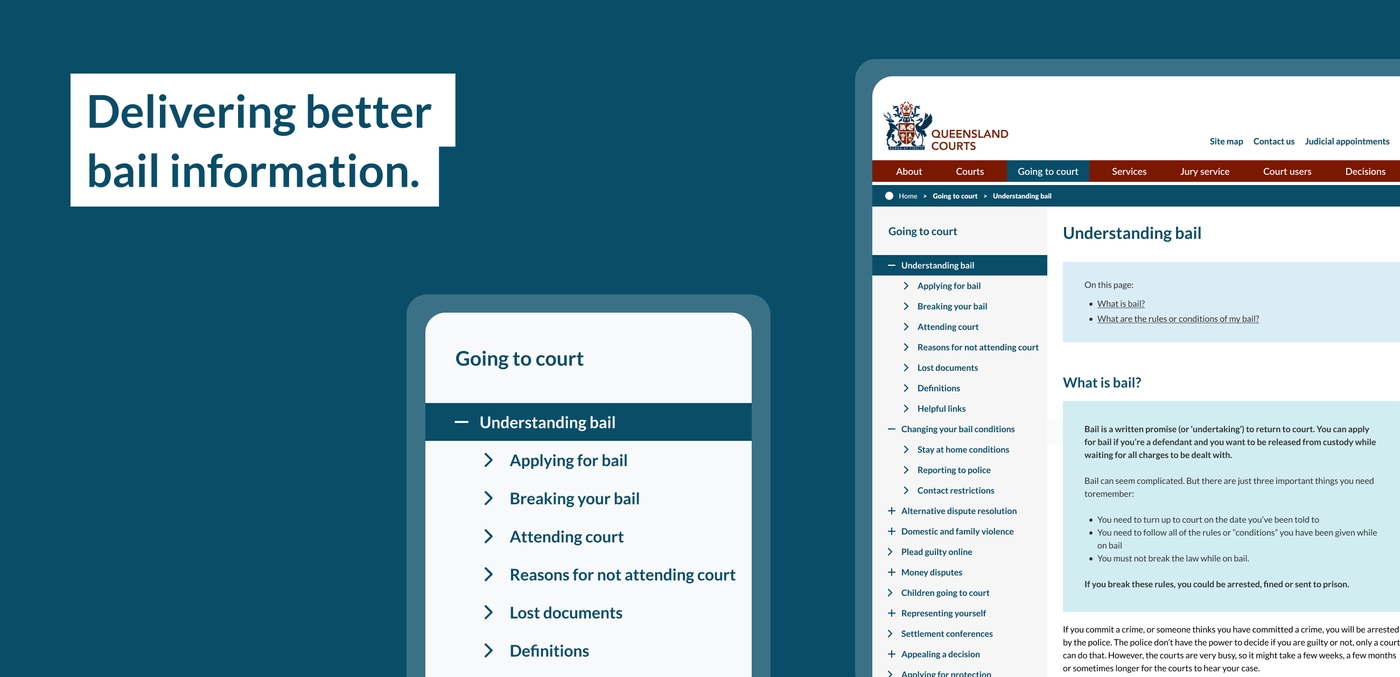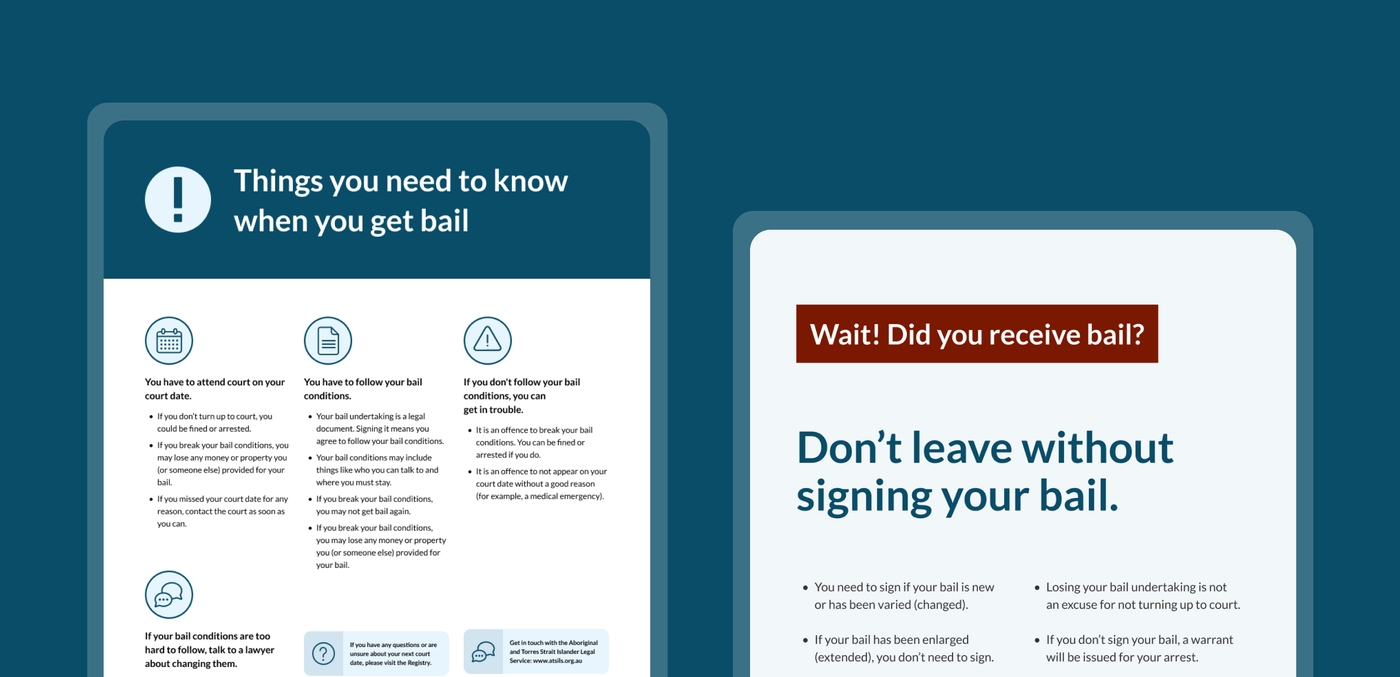
The Integrated Criminal Justice Program engaged Portable to help people who are charged with offences and given bail conditions, find and understand bail information.
An ongoing issue the Queensland government faces is that people on bail don’t comply with their conditions which is often the result of;
- Not understanding the conditions
- Losing or throwing away bail information provided or not knowing where to find information about their bail
- Not having the ability to read, comprehend or understand the conditions
- English being a second language and/or;
- Minimal reminders to reinforce attendance
Responsible for Business Transformation in the Integrated Criminal Justice Program, the project’s Principal Advisor, Deb McGoldrick, had Portable on her radar for sometime due to our depth of knowledge and experience in the legal design space. Deb recognised the Bail Information Accessibility Project as an exciting opportunity to co-design a solution. Deb was focussed, knowledgeable and passionate about improving information for bailed defendants and worked closely with our team to shape the final solution. Her primary goal was to ensure bail information was accessible to defendants both online and offline, and presented in a simplified format.
The Challenge
Working to tight design constraints, we developed a range of online and offline resources to better communicate and educate defendants about bail.
Design of offline assets to better communicate bail information
We started the project by conducting a series of independent research activities which leveraged findings from previous research about how to best present bail information. We then validated these findings with key stakeholders which led to the development of several design assets that were tested with a range of participants.
Our research led us to uncover three distinct issues:
- Understanding
People don’t comply with bail requirements when they don’t understand them. Defendants may throw away or lose their bail information. And even when they don’t, the forms are full of language that not everyone understands. - Vulnerability
This is especially problematic for people who struggle with addiction, acquired brain injuries, or have low levels of written English comprehension. - Severity
For many people, the punishment they receive for not adhering to bail conditions outweighs the penalty for their initial crime. They end up getting stuck in the system, which is not what bail is for.
Testing and refining a more human-centred information architecture
We then strengthened existing bail information and content provided by the Behavioural Insights Team for the Queensland Government, to better accommodate the user's needs. We worked together with lawyers and defendants to restructure this content, rolling it out across the Queensland Courts official website.
Our Approach
We took an iterative design approach to this project. The insights from our desktop research shaped how we engaged subject matter experts, which in-turn informed how we approached design and delivery.
It should be noted that our research indicated that non-compliance also requires systemic intervention. As part of this project, we focused on addressing how information is presented to the target audience and how to engage, inform and communicate clearly using visual design tools. However, there is scope in the future for other interventions to explore the improving the experiences of people going through the bail process and addressing the complex internetworked patterns of behaviour in culture and society that exacerbate and proliferate issues relating to bail non-compliance.
Literature review
Our literature review helped us to deepen our understanding of the problem space. We reviewed how others present bail information and absorbed several academic papers, government reports and articles. Our market mapping highlighted several key opportunities for improving bail information:
- Using icons and process maps to support bail content
- Using a variety of communication methods (for example, the Department of Justice Tasmania uses video to support people Going to Court and the Blurred Borders project, demonstrated how visual art, plain language and storytelling can be used to enhance communication)
- Adopting messaging on cell walls
- Making court information engaging
- Reminding people to sign their undertaking
- Guiding Defendants through action-oriented pathways
- Creating an omni-channel experience
Interviews with Subject Matter Experts
We then conducted interviews with subject matter experts, which influenced our approach to workshops and design activities. We learnt how people access and interact with bail information and the wider systemic issues impacting on bail adherence.
Process mapping
As part of our synthesis, we mapped user flows across relevant bail information media and clarified the context of how and when a person would encounter or be influenced to access bail information. These visual representations enabled us to communicate how the bail process worked in a concise and straightforward way. They also helped us to seek feedback from others to identify gaps and pinpoint opportunities to explore further. For each stage of the bail process, we analysed:
- The steps the Defendant could expect to take, including a description of key moments
- The information that was provided to the Defendant
- What helped or hindered Defendants from actively seeking information, advice or support about their bail
- What opportunities exist to engage, inform and communicate the message to the audience using visual design tools
Design
We developed a series of online clickable wireframes and offline design assets. We then conducted usability testing of wireframes, navigation, and offline resources with Defendants and members of the DJAG team to test our assumptions about the best ways to structure and present information.
When testing our designs, we discovered that:
- Many defendants knew of terms related to the bail process but they didn’t know what these words meant. We recommended a “content design pattern” to be used across all design assets that would help with consistency (i.e. how to refer to bail forms).
- Defendants wanted clarity over what they should do, not what would happen. They highlighted this when they were testing the designs, which validated what we had already heard (their behaviours tend to be reactive not proactive).
- References to bail should appear throughout the Queensland Courts website (not only within the designated section), given the complex nature of the defendant's situations and their mental models. For example, when asked “Where would you go to find out more information about contacting someone you’re not allowed to?” a defendant answered “domestic and family violence”.
- Information about bail can be enhanced with the addition of visuals and iconography, especially for those with low literacy.
- A poster that is designed to stop defendants from leaving court without signing is highly desirable, given the tendency of bailed defendants to leave court without signing. However, given how crowded courtroom notice boards already are, signage needs to be directed to defendants and striking.
- Given the difficulty associated with changing Forms 7 & 8, a pamphlet that sits alongside these forms that explains key concepts is also highly desirable.
Outcomes
The outcomes of this project were immediate and future focussed. Our team proposed a simplified IA experience for the Queensland Courts website, and suggested recommendations to the content proposed by the Behavioural Insights Team; Improving bail information in Queensland report. A print ready poster and pamphlet that clarify and reiterate key conditions and consequences of bail non-compliance were also supplied.
The team provided future recommendations including using more visual methods of communication (images, stencilling and videos) across high traffic areas such as websites, courthouses and cells. Also, the redesigning Form 8 (Notice to defendant of undertaking as to bail), scripts for courthouse clerks to reference when helping defendants understand conditions, and targeted resources for those with English as a second language.
A key learning was being unable to access defendants for user testing and feedback sessions. Despite numerous attempts and approaches, this proved difficult. Although we were able to include the perspective of two defendants, we were unable to increase the participant numbers to understand first hand experience and the challenges people face in this area. As a result, first responders, legal counsel, bail Subject Matter Expert, police and courts staff were relied on for user testing.

Looking Forward
We have set out several recommended approaches for monitoring, evaluating and continually improving the new designs once they are implemented, recognising that these changes are part of a whole system approach to better supporting bail defendants.
By revising the information architecture and content on the Queensland Courts website, introducing posters into courthouses and providing explanatory materials to bailed defendants with Form 7 and 8, we believe this will lead to defendant’s changing their behaviour and feeling less fear, shame and embarrassment associated with attending court, and eventually resulting in fewer people being charged with ‘failure to appear’.
Reflections
Our project team loved working with Deb and the Integrated Criminal Justice Program. We’ve taken what we learned from our extensive research with several defendants, lawyers, police and other stakeholders and our broad scan of what other jurisdictions have done to present information about bail, to create a series of assets that seek to support defendants to comply with their bail conditions and find help when they need it. Key to our work was to draw attention through carefully crafted content, and visuals and make it easy to navigate to relevant information. We look forward to seeing these designs published and helping defendants find bail information easier.
Emily MacLoud, Portable Design Strategist
Project Team
- Luke Thomas, Senior UX Researcher
- Emily MacLoud, Design Strategist
- Lucy Boehme, Experience Designer
- Tess Waterhouse, Senior Digital Producer
- India Lock, Design Strategist